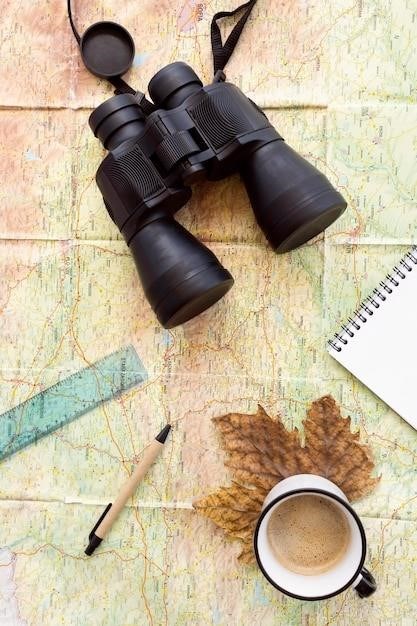Setting Up Your National Geographic Telescope
Begin by setting up your National Geographic telescope on a stable surface. This Newtonian reflector‚ featuring a 114mm aperture‚ is ideal for deep-sky observation. It includes two eyepieces‚ a panhandle mount for smooth movement‚ a carbon fiber body‚ and a smartphone adapter for easy image sharing. Assemble the telescope in daylight to familiarize yourself with the components and steps before nighttime viewing.
Unboxing and Component Identification
Carefully open the packaging and lay out all the components. Identify the main parts⁚ the optical tube assembly (OTA)‚ which houses the mirrors and lens; the tripod‚ providing a stable base; and the mount‚ which attaches the OTA to the tripod and allows for movement. You should also find two eyepieces of differing magnifications‚ clearly labeled as such. Locate the finder scope‚ a smaller telescope used to locate celestial objects before viewing through the main telescope. Check for the included smartphone adapter‚ enabling easy astrophotography. Inspect all parts for any damage before proceeding; refer to the manual for detailed diagrams and explanations if needed. Ensure that all screws are tight and all parts are undamaged. Remember to keep small parts away from children‚ as noted in safety warnings. Familiarize yourself with each component’s purpose‚ ensuring you understand how they fit together before beginning assembly. The manual provides detailed illustrations.
Setting up the Tripod
Fully extend the tripod legs until the tripod spreaders are fully extended‚ ensuring a stable and level base for your telescope. Choose a flat‚ stable surface‚ free from obstructions and vibrations‚ for optimal viewing. Ensure the ground is level to prevent wobbling and maintain a clear‚ steady view of the night sky. Once the legs are extended‚ carefully adjust their length to achieve a comfortable viewing height. This will depend on your height and preferences‚ aiming for a position that minimizes strain during observation. For equatorial mounts‚ level the tripod using the adjustable feet‚ ensuring the mount is properly aligned before attaching the telescope tube. Consider using a bubble level to ensure precise leveling. A stable tripod is crucial for sharp‚ clear images; take the time to set it up correctly before moving to the next step. Remember to secure the legs firmly to prevent accidental collapse.
Attaching the Telescope Tube
Carefully lift the optical tube assembly (OTA) and align the dovetail mounting plate with the corresponding slot on the equatorial mount or alt-azimuth mount. Gently slide the OTA onto the mount until it is securely fastened. Ensure the connection is firm and stable to avoid any movement or vibrations during observation. Check for any loose screws or connections and tighten them if necessary. Do not force the connection; if it feels resistant‚ double-check the alignment of the dovetail plate. Once the OTA is firmly attached‚ check the balance of the telescope. If it tips towards one side‚ you may need to adjust the position of the finder scope or other accessories. A balanced telescope is essential for smooth and precise movements when tracking celestial objects. Take your time and ensure everything is securely fastened before proceeding to the next stage of setting up your National Geographic telescope.

Aligning Your Telescope
Proper alignment is crucial for optimal viewing; This involves polar alignment (if applicable) and precise focusing to achieve a sharp‚ clear image of celestial objects. Follow the instructions carefully for best results.
Polar Alignment (if applicable)
Polar alignment is a crucial step for equatorial mounts‚ ensuring your telescope tracks celestial objects accurately throughout the night. If your National Geographic telescope has an equatorial mount‚ this process is essential. First‚ locate Polaris‚ the North Star. Use a compass or star chart to accurately determine the celestial north. Then‚ carefully adjust the altitude and azimuth of your mount until the polar axis points directly at Polaris. Some telescopes have a built-in polar scope to assist in this process. Accurate polar alignment significantly improves tracking‚ preventing objects from drifting out of view during long observation sessions. Take your time; precise alignment is key to successful deep-sky astrophotography and extended observation periods. If your telescope uses an alt-azimuth mount‚ you can skip this step. Alt-azimuth mounts do not require polar alignment.
Focusing the Telescope
Focusing your National Geographic telescope is crucial for sharp‚ clear images. Begin by selecting a bright‚ easily identifiable celestial object‚ such as the Moon or a bright star. Look through the eyepiece and use the focusing knob – usually a large‚ easily accessible wheel on the telescope tube – to adjust the focus. Slowly turn the knob‚ observing the object’s appearance. You’ll notice the image will become progressively clearer as you approach the optimal focus point. If the image appears blurry or out of focus at its sharpest point‚ try adjusting the focus knob again. The focus may be slightly different for each eyepiece‚ so repeat this process if you switch eyepieces. Take your time to achieve a crisp‚ detailed view. Remember‚ perfect focus maximizes your viewing experience and allows you to appreciate the fine details of celestial objects. Experiment with the focus knob until you achieve optimal clarity and sharpness.
Using Your Telescope Eyepieces
Your National Geographic telescope likely includes multiple eyepieces offering varying magnifications. Experiment to find the best eyepiece for your observation target and personal preference. Remember that higher magnification isn’t always better; it can reduce brightness and clarity.
Understanding Magnification
Magnification in telescopes is determined by the focal length of the telescope and the focal length of the eyepiece. The formula is⁚ Magnification = Telescope Focal Length / Eyepiece Focal Length. For example‚ a telescope with a 500mm focal length and a 25mm eyepiece provides 20x magnification (500mm / 25mm = 20x). Higher magnification doesn’t automatically mean a better view. Atmospheric conditions‚ the quality of the optics‚ and the brightness of the celestial object all play crucial roles. Excessive magnification can result in a dimmer‚ less-detailed image due to atmospheric turbulence or the inherent limitations of the telescope’s aperture. Experiment with different eyepieces to find the optimal magnification for your target and observing conditions. Remember that a stable tripod and precise focusing are essential for achieving sharp images at higher magnifications.
Choosing the Right Eyepiece
Your National Geographic telescope likely comes with several eyepieces offering different magnifications. Eyepieces with longer focal lengths provide lower magnification‚ ideal for wider field views of larger celestial objects like nebulae or star clusters. Shorter focal length eyepieces offer higher magnification‚ suitable for observing smaller‚ brighter objects like planets or the moon. Consider the size and brightness of your target when selecting an eyepiece. For example‚ observing faint nebulae requires a lower magnification for a brighter image. Observing planets might benefit from higher magnification for increased detail‚ provided atmospheric conditions are stable. Experiment with different eyepieces to find what works best for various celestial targets and conditions. Remember that higher magnification isn’t always better; a clear‚ bright image at lower magnification is often preferable to a blurry‚ dim image at higher magnification.

Observing with Your Telescope
Once aligned and focused‚ begin exploring! Use star charts or astronomy apps to locate celestial objects. Remember to allow your eyes to adjust to the darkness for optimal viewing. Enjoy the wonders of the night sky!
Finding Celestial Objects
Successfully locating celestial objects with your National Geographic telescope hinges on preparation and technique. Begin by consulting a star chart or a user-friendly astronomy app like Stellarium or SkySafari. These tools pinpoint the locations of stars‚ planets‚ and deep-sky objects‚ crucial for directing your telescope. Identify easily recognizable constellations to orient yourself‚ using bright stars as reference points. Start with brighter‚ easier-to-find objects like the Moon‚ Jupiter‚ or Saturn before progressing to more challenging targets. Remember that atmospheric conditions significantly impact visibility; clear‚ dark skies are optimal. Practice using the telescope’s slow-motion controls for precise aiming and avoid jerky movements that might disorient your view. When locating faint objects like nebulae or galaxies‚ use averted vision—looking slightly away from the target can enhance visibility. Patience and persistence are key; allow ample time for your eyes to adjust to the darkness and for your telescope to settle. Most importantly‚ enjoy the exploration!
Troubleshooting Common Issues
If your National Geographic telescope isn’t providing a sharp image‚ begin by carefully checking the focus. Slowly rotate the focusing knob until the object is crisp and clear; slight adjustments might be needed depending on the celestial body and eyepiece used. A blurry image can also result from improper alignment; Ensure that the telescope is properly aligned‚ addressing any issues with the tripod’s stability or the telescope’s mount. Collimation problems‚ where the mirrors aren’t properly aligned‚ can result in a distorted or fuzzy image; consult your manual for collimation instructions. If the image is dim‚ ensure that you’re using the appropriate eyepiece for the object’s brightness and that the optical path is clear of obstructions. Atmospheric conditions like haze or light pollution can also affect image quality; observing from a location with minimal light pollution will significantly improve visibility. Remember to allow your eyes sufficient time to adjust to the darkness. For persistent problems‚ consider consulting online resources or contacting customer support for further assistance. Document your issues for quicker resolution.
Maintaining Your Telescope
Regular cleaning of the lenses with a soft cloth and specialized cleaning solution is crucial. Proper storage in a dry‚ dust-free environment‚ using a protective cover‚ will extend the life and performance of your National Geographic telescope.
Cleaning the Lenses
Cleaning your National Geographic telescope’s lenses requires a gentle touch and the right tools to avoid scratches or damage. Begin by inspecting the lenses for dust or debris. Use a soft brush‚ like a camel hair brush‚ to gently remove loose particles. For stubborn dirt‚ use a blower bulb to dislodge it. Never touch the lens surface directly with your fingers. For more persistent smudges‚ use a lens cleaning pen or a microfiber cloth specifically designed for optics. Apply a small amount of lens cleaning solution to the cloth‚ not directly onto the lens. Gently wipe the lens in a circular motion‚ applying minimal pressure. Always clean in a well-lit area to ensure you remove all particles. After cleaning‚ inspect the lens again to ensure all smudges and marks have been removed. Store your cleaned lenses appropriately to prevent future dust accumulation‚ ideally in a climate-controlled environment.
Storage and Protection
Proper storage is crucial for extending the lifespan of your National Geographic telescope. After each observing session‚ allow the telescope to cool down to room temperature before packing it away to prevent condensation. Always use the original packaging or a custom-fitted case to protect it from bumps and scratches during transport. Store the telescope in a cool‚ dry place away from direct sunlight‚ extreme temperatures‚ and high humidity. These conditions can damage the optical components and the telescope’s mechanical parts. Keep the telescope’s lenses capped to prevent dust and debris from settling on them. If you’re storing the telescope for an extended period‚ consider using desiccant packs inside the case to absorb moisture. Regularly inspect the telescope for any signs of damage or wear and tear. Addressing minor issues promptly can prevent more significant problems later. Following these guidelines will help ensure your National Geographic telescope remains in optimal condition for years of celestial exploration.
Leave a Reply
You must be logged in to post a comment.